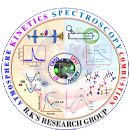The temperature-dependent reaction kinetics of methyl cyclohexane (MCH) and methyl cyclopentane (MCP) with Cl atoms were experimentally explored via the relative rate technique. Gas chromatography coupled with a flame ionization detector was employed to follow the reactant as well as the reference compound concentrations during the course of reaction. Gas chromatography coupled with mass spectrometry and gas chromatography coupled with infrared spectroscopy were used as the diagnostic tools for the detection and identification of the products in the title reaction. The rate coefficients for the reaction of Cl atoms with methyl cyclohexane and methyl cyclopentane were measured in the temperature range of 283–363 K at 760 Torr using isoprene and propylene as reference compounds. To support the experimental results, computational calculations were performed over the temperature range of 200–400 K using canonical variational transition state theory coupled with small curvature tunneling (CVT/SCT), conventional transition state theory (CTST) coupled with Wigner tunneling corrections, and CVT coupled with Wigner tunneling methods using the MP2 level of theory with 6-31G(d,p) as the basis set. The temperature-dependent rate coefficients were measured for the reaction of methyl cyclohexane and methyl cyclopentane with Cl atoms to be k(MCH) = [(4.48 ± 0.75) × 10–11]exp[(604 ± 25)/T] cm3 molecule–1 s–1 and k(MCP) = [(5.71 ± 0.66) × 10–12]exp[(1819 ± 669)/T] cm3 molecule–1 s–1, respectively. The measured rate coefficients at 298 K for the reactions of Cl atoms with methyl cyclohexane and methyl cyclopentane are k298 KMCH = (3.36 ± 0.34) × 10–10 cm3 molecule–1 s–1 and k298 KMCP = (2.25 ± 0.24) × 10–10 cm3 molecule–1 s–1, respectively. The conceivable atmospheric degradation mechanism for the reaction of methyl cyclohexane as well as methyl cyclopentane with Cl atoms was projected based on the products obtained during the reaction. Atmospheric implications, cumulative atmospheric lifetimes, thermochemistry, ozone formation potentials, and branching ratios of these molecules were also calculated and have been reported in this article. Supporting Information
-
Call
-
E-mail
Journal Details
1. Cl Atom Initiated Atmospheric Degradation of Saturated Cyclic Hydrocarbons – Kinetic and Mechanistic Investigation.
R. C. Balan & B. Rajakumar. J. Phys. Chem., , 7361-73., 123, 34
